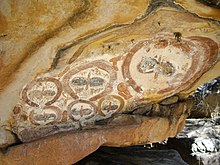ワンジナ
ワンジナ[1](Wandjina[2]; Wondjina, Wondjiina[3] ウォンジーナ[注 1] の表記もみられる)は、オーストラリア・アボリジニの神話に登場する存在。大陸北西部・キンバリー地域の伝承に登場し、神[4]や精霊[8]とされる。岩絵が有名である。

ワンジナと呼ばれる存在は複数存在する。例えばワシタカのワラナ[9](Warana the Eaglehawk[10])という名のワンジナについて、以下のような伝承がある。ワラナはある時、2つの卵を巣に残してカンガルー狩りに出かけたところ、その卵をイワバトのウォドイ[11](Wodoi the Rock Pigeon[10])に盗まれてしまった。ワラナはウォドイを追いかけたが、ウォドイの友人であるフクロウのジュングン[12](the owl Djunggun[10])に投棒とブーメランで殺されてしまった。ワラナは岩絵に変じ、2つの卵は洞窟の外の2つの石に変じたという[10][13]。
またワラガンダ(Walaganda[14][注 2]; 「天空に属するもの」を意味する[19][20][21])という名のワンジナは、不定形の存在であったが、天空に昇り天の川に変じたという[10][22]。
ほとんどすべてのワンジナは岩絵へと変じたが、その魂は近くの聖なる泉に降り、そこで人々は活力を得ることができるという[23][22][13]。
ワラガンダについては、天の川より来たりて大地と全ての人々を創造した、とする伝承もある[26]。
ヌニンドゥアンゴ[27] (Nunind'ango) という名のワンジナもいる[28]。
ワンジナは降雨の神とされる[4][22]。岩絵では通常口が描かれないが、もしワンジナに口があれば雨が降り続けるであろう、という伝承がある[29][13]。
ワンジナの岩絵は、乾季になると降雨を祈念して描き直された[29]。ワンジナの岩絵のデザインはほぼ共通である[29][13]。また虹蛇の岩絵の近くに描かれることも多い[29]。
ワンジナの岩絵をヨーロッパ人として初めて記録したのは、軍人・探検家でもあったジョージ・グレイである[29][30]。彼は1838年に岩絵を発見した[29][30]。
ギャラリー
編集脚注
編集注釈
編集出典
編集- ^ 「ワンジナ」の表記は松山 (2008), pp. 156, 159–160 にみられる。
- ^ 「Wandjina」の表記は紙村 (2013), p. 115, Layton (1992), p. 34 などにみられる。
- ^ 「Wondjina」の表記はPoignant (1967), pp. 120–122, Lurker (1987), p. 379 などにみられる。「Wondjiina」の表記は紙村 (2013), p. 115 にみられる。
- ^ a b c コトバンク「ウォンジナ」.
- ^ ポイニャント & 豊田 1993, 目次.
- ^ 松山 2008, p. 159(引用文内).
- ^ ロンメル & 大林訳 1964, pp. 23, etc..
- ^ 松山 2008, p. 156.
- ^ 「ワシタカのワラナ」の表記はポイニャント & 豊田 (1993), p. 298; 紙村 (2013), p. 115 にみられる。
- ^ a b c d e Poignant 1967, p. 120.
- ^ 「イワバトのウォドイ」の表記はポイニャント & 豊田 (1993), p. 298 にみられる。
- ^ 「フクロウのジュングン」の表記はポイニャント & 豊田 (1993), p. 298 にみられる。「フクロウのジュグン」の表記は紙村 (2013), p. 115 にみられる。
- ^ a b c d 紙村 2013, p. 115.
- ^ 「Walaganda」の表記はLurker (1987), p. 379 にみられる。
- ^ 「Walangada」の表記はPoignant (1967), p. 120 にみられる。
- ^ 「ワランガダ」の表記はポイニャント & 豊田 (1993), p. 298 にみられる。
- ^ 「Walanganda」の表記はLayton (1992), p. 34, Elkin No.7, p. 2 にみられる。
- ^ Mowanjum.
- ^ Poignant 1967, p. 120
belonging to the sky
- ^ Lurker 1987, p. 379
he who belongs to heaven
- ^ 「天空に属するもの」の表記はポイニャント & 豊田 (1993), p. 298 にみられる。
- ^ a b c Lurker 1987, p. 379.
- ^ Poignant 1967, pp. 120–122.
- ^ “Mowanjum Aboriginal Art & Culture Centre :: Mabel King”. 2023年9月17日閲覧。
- ^ “Kimberley Indigenous artist dies - ABC News”. 2023年9月17日閲覧。
- ^ Mowanjum. アボリジニ、ンガリニン族出身の古老・アーティスト Mabel King (1930年[24] - 2006年[25])の語りによる。
- ^ 「ヌニンドゥアンゴ」の表記はポイニャント & 豊田 (1993), p. 301 にみられる。
- ^ Poignant 1967, p. 126.
- ^ a b c d e f Poignant 1967, p. 122.
- ^ a b 松山 2008, p. 160.
参考文献
編集- Poignant, Roslyn (1967). Oceanic mythology : the myths of Polynesia, Micronesia, Melanesia, Australia. London: Paul Hamlyn. NCID BA10794990
- 日本語訳は ポイニャント, ロズリン 著、豊田由貴夫 訳『オセアニア神話』青土社、1993年。ISBN 978-4791752515。
- Lurker, Manfred. Dictionary of gods and goddesses, devils and demons. London and New York: Routledge & Kegan Paul - 2004年の再版あり(ISBN 978-0415340182)
- 紙村, 徹 著「ウォンジーナ」、松村一男、平藤喜久子、山田仁史 編『神の文化史事典』白水社、2013年2月9日、115-116頁。ISBN 978-4-560-08265-2。 - 2023年の再版あり(ISBN 978-4560093825)
- 出典・参考文献として「マドック『オーストラリアの原住民』」「小澤編『世界の民話 オーストラリア』」の2点が挙げられている。
- 鈴木二郎「ウォンジナ」『世界大百科事典』。コトバンクより2023年8月16日閲覧。
- 松山, 利夫 (2008). “「オーストラリア原始美術」展とその民族学的背景 : 日本最初のアボリジナル美術展をめぐる資料の紹介”. 国立民族学博物館研究報告 32 (2): 149-236.
- ロンメル, アンドレアス 著、大林太良 訳『美のあけぼの : オーストラリアの未開美術』社会思想社〈現代教養文庫〉、1964年5月15日。 NCID BN06601337。
- Layton, Robert (1992). Australian Rock Art : A New Synthesis. Cambridge University Press. ISBN 9780521346665
- “University of Sydney Archives > Personal archives of AP Elkin > No.7: Correspondence, translations, and fieldnotes of HJ Coate (Date Range: 1928–1979)”. シドニー大学. 2023年8月16日閲覧。 (親ページ) - A. P. Elkinの資料目録
- “history & culture - Mowanjum Artsists Spirit of the Wandjina Aboriginal Corporation”. 2023年9月17日閲覧。
関連文献
編集- Love, James Robert Beattie (1930). “Rock paintings of the Wororra and their mythological interpretation”. Journal of the Royal Society of Western Australia 16: 1-24. - リンク先はBiodiversity Heritage Libraryの電子テキスト(Royal Society of Western Australiaのリンクページ)。2頁にワンジナ (Wónjuna) の言及あり。
- Capell, A. (1939). “Mythology in Northern Kimberley, North-West Australia”. Oceania (Wiley) 9 (4 (Jun., 1939)): 382-404 (23 pages). - Walanganda(ワランガンダ)の言及がある模様。
- Capell, A. (1960). “Language and World View in the Northern Kimberley, Western Australia”. Southwestern Journal of Anthropology (The University of Chicago Press) 16 (1 (Spring, 1960)): 1-14 (14 pages).
- Mowaljarlai, David; Malnic, Jutta (1993). Yorro Yorro: everything standing up alive. Magabala Books. ISBN 978-0892814602 - 2017年再版 (ISBN 978-1925360059) あり。
- Akerman, Kim (2016). Wanjina: Notes on Some Iconic Ancestral Beings of the Northern Kimberley. Hesperian Press. ISBN 978-0-85905-628-1
- 書評論文: Rainsbury, Michael P.. “Review: Wanjina: Notes on Some Iconic Ancestral Beings of the Northern Kimberley”. Aboriginal History (ANU Press) 40: 359–361.